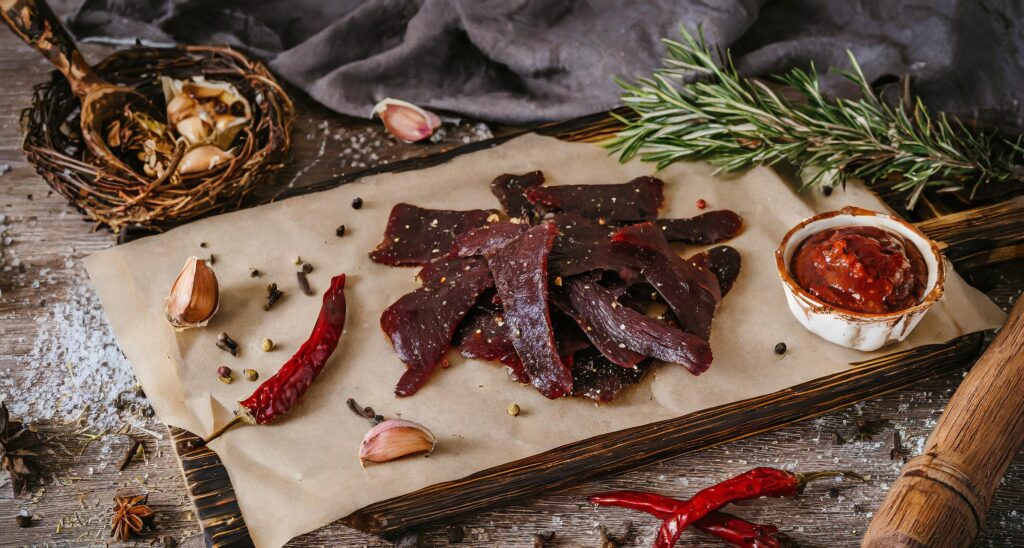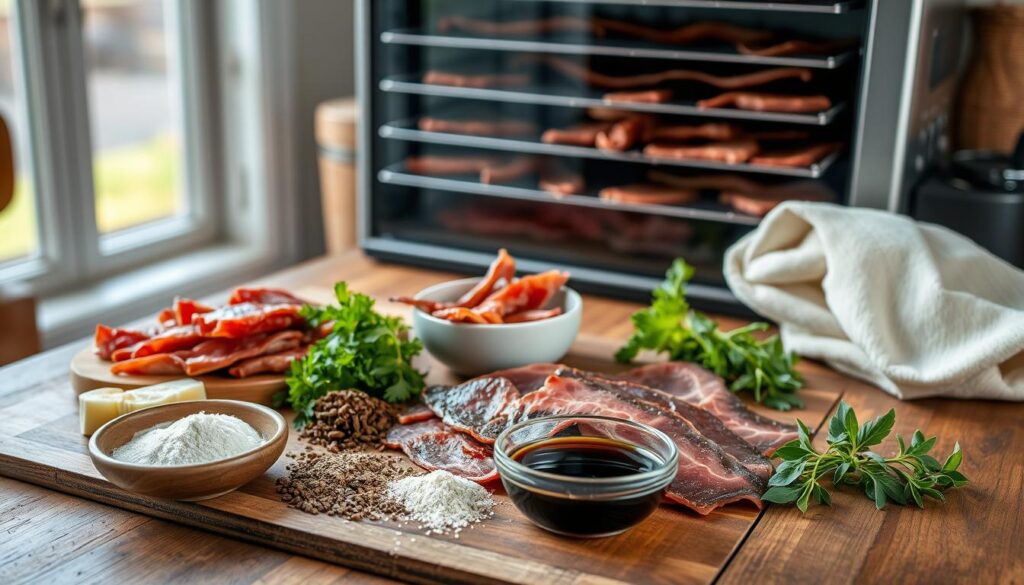The act of crafting something from raw materials imbues a profound sense of accomplishment, a sentiment magnified when the creation is as delectable as homemade deer jerky recipe. My journey into the realm of venison jerky commenced last autumn, with the kitchen enveloped in the intoxicating scent of marinated venison. This aromatic backdrop evoked memories of countless afternoons spent with family, sharing tales and snacks beneath the starlit sky. It was in that instant that I recognized the significance of this endeavor, not merely as a culinary pursuit but as a bridge to the rich traditions of the hunting fraternity.
The art of crafting ground venison jerky recipe at home is a deeply fulfilling endeavor. By employing the correct methodologies and utilizing premium components, one can produce a jerky that surpasses commercial offerings. This guide aims to equip you with the knowledge necessary to create your own homemade jerky, from the selection of the ideal venison cut to the intricacies of the marinating process. Each phase is meticulously crafted to facilitate the attainment of jerky excellence. Embark with me on this exploration into the realm of jerky, a delicacy steeped in cultural heritage and bursting with flavor.
Table of Contents
Introduction to Deer Jerky
The deer jerky marinade history is a testament to the ingenuity of ancient civilizations, with its genesis in the preservation techniques of Native Americans. Initially, jerky was a vital component of their survival strategy, ensuring sustenance during the harshest winter months. These pioneering methods have evolved, influencing the contemporary preference for a protein-rich snack among outdoor aficionados and hunters.
The contemporary allure of homemade deer jerky recipe is driven by a burgeoning interest in health-conscious, high-protein alternatives. Derived from the leanest cuts of venison, this snack caters to a diverse array of dietary needs. The resurgence in homemade venison jerky production reflects a broader trend towards self-sufficiency in food preparation.
Venison jerky stands out as a preferred choice for its distinctive flavor, convenience, and nutritional value. It serves as an excellent companion for outdoor activities, providing a revitalizing and satisfying snack. This practice of jerky making connects me to a rich narrative of sustenance and resilience.
Delving into the art of deer jerky recipe creation reveals its profound cultural and culinary significance. This exploration will deepen our understanding of this timeless snack, elevating it beyond mere sustenance to a cherished tradition.
Benefits of Making Homemade Jerky
The act of crafting my own jerky unveils a plethora of advantages, each with its own distinct appeal. The capacity to personalize flavors stands out as a primary benefit. I have the freedom to experiment with diverse spices and marinades, ensuring that every batch of homemade venison jerky aligns with my individual taste preferences. This level of personalization is an unattainable luxury with commercially available jerky.
Another critical advantage lies in the control over the ingredients used. By preparing homemade jerky, I am able to select premium components, steering clear of the preservatives and additives that are prevalent in commercial products. This approach not only enhances the flavor but also contributes to the nutritional value of each piece, making it a healthier choice.
Cost-effectiveness is a further incentive for me to engage in homemade jerky production. Purchasing jerky from retail outlets can be prohibitively expensive, a concern exacerbated by the need for bulk purchases. In contrast, creating jerky at home allows for significant cost savings, enabling me to produce larger quantities while adhering to a budget. This method is invaluable for meal planning, providing a nutritious and convenient snack that complements my dynamic lifestyle.
In conclusion, the advantages of homemade jerky transcend mere taste preferences. These benefits collectively contribute to a more balanced diet and an efficient means of enjoying snacks, ensuring quality and flavor without compromise.
Essential Ingredients for My Deer Jerky Recipe
The art of crafting homemade venison jerky recipe hinges on the selection of its constituent parts. Mastery over the selection of key ingredients can significantly enhance the quality of your final product. This discourse will elucidate the process of identifying the most suitable venison cuts and the quintessential components of a delectable deer jerky marinade.
Choosing the Right Cut of Venison
The selection of venison cuts is a critical determinant in the creation of deer jerky marinade. Favoring lean cuts is imperative for achieving the desired texture and minimizing fat content. Recommended cuts include:
- Loin
- Flank
- Round
These cuts are not only tender but also adept at absorbing marinades. It is essential to ensure the freshness of the meat for optimal results. The synergy of flavor and texture begins with the selection of premium venison cuts.
Key Marinade Ingredients
A meticulously formulated deer jerky marinade is instrumental in elevating the overall taste profile. The marinade’s key components are:
- Soy sauce
- Garlic powder
- Brown sugar
- Black pepper
- Worcestershire sauce
These ingredients synergize to create a rich tapestry of flavors while also aiding in the preservation of the meat during the drying phase. A judicious blend of sweet and savory elements contributes to the jerky’s depth, culminating in a superior snacking experience.
Step-by-Step Guide to Making Deer Jerky
The art of crafting ground venison jerky recipe necessitates meticulous preparation of the venison, followed by a deliberate marinating process. This guide will elucidate the steps required to ensure the venison is optimally prepared for flavor absorption, culminating in a delectable final product.
Preparing the Venison
In the initial phase, I select a cut of venison, such as the backstrap or hindquarters, which are lean and ideal for jerky. The subsequent steps are as follows:
- Trim the fat: Excess fat must be removed, as it can contribute to spoilage.
- Slice the meat: I slice the venison into thin strips, approximately 1/4 inch thick. This facilitates even drying and improves texture.
- Clean the meat: Maintaining the meat’s cleanliness is critical for food safety. I ensure my hands are thoroughly washed and employ sanitized cutting boards and knives.
Marinating the Meat
Following the venison preparation, I proceed to marinate the deer jerky marinade. A superior marinade is essential for imparting rich flavors. Here’s my approach:
- Select the marinade: I concoct a blend of soy sauce, garlic, and spices, tailored to my personal taste preferences.
- Marinate for the right duration: I allow the meat to marinate for at least 6 to 12 hours. This duration is necessary for optimal flavor penetration.
- Use a resealable bag: I encase the venison strips in a plastic bag, ensuring they are thoroughly coated and the air is evacuated for enhanced marinating.

My Favorite Deer Jerky Recipe Marinade Recipes
The art of crafting exceptional deer jerky recipe frequently commences with the selection of a marinade. I have two preferred recipes that significantly augment the flavor of my smoked venison jerky, rendering it memorable. These marinades are straightforward to concoct and permit for customization based on individual taste preferences.
Sweet and Spicy Marinade
This sweet and spicy jerky recipe achieves a harmonious equilibrium between the piquancy of heat and the mellowness of sweetness. Here’s the method I employ:
- 1/2 cup honey
- 1 tablespoon cayenne pepper
- 1 teaspoon garlic powder
- 1/2 cup soy sauce
- 1 teaspoon black pepper
Mix all components until they are thoroughly blended. Permit the venison to marinate for a minimum of 8 hours, or overnight for an intensified flavor absorption. Modify the cayenne to suit your desired level of spiciness.
Teriyaki Marinade
This teriyaki smoked venison jerky is ideal for aficionados of an Asian-inspired flavor profile in their jerky. Here’s the composition I utilize:
- 1/2 cup soy sauce
- 1 tablespoon grated ginger
- 1 tablespoon sesame oil
- 1/4 cup brown sugar
- 1 teaspoon garlic powder
Combine all ingredients in a bowl, stirring until the sugar is fully dissolved. Marinate the venison for at least 6 hours to achieve a delectable teriyaki flavor. The sweetness can be modulated by adjusting the brown sugar quantity.
These marinades not only enhance the taste but also serve as an excellent means to explore various flavor combinations. Each marinade can be modified to achieve the perfect flavor balance tailored to your taste preferences.
Smoking Venison Jerky Like a Pro
Smoked venison jerky imbues it with a profound depth of flavor, elevating the culinary experience to new heights. Achieving this authentic smoky essence necessitates the selection of appropriate wood types for smoking. Each wood variety imparts a distinct flavor profile, enriching the jerky and rendering it unforgettable.
Best Types of Wood for Smoking
For smoked venison jerky, a variety of wood types can be employed, each contributing a unique flavor:
- Hickory: Renowned for its robust, smoky essence, it harmonizes exceptionally well with venison.
- Mesquite: Characterized by a bold, intense flavor, it is ideal for those who prefer a more pronounced smoke.
- Apple: Offers a mild, sweet taste, complementing the natural richness of the meat.
- Cherry: Introduces a subtle sweetness and enhances the jerky’s color.
Timing and Temperature for Perfect Results
Mastering smoked venison jerky techniques requires an understanding of optimal timing and temperature. I advocate for a smoker temperature between 160°F and 185°F for superior results. Below is a concise summary:
| Wood Type | Temperature Range (°F) | Smoking Time (Hours) |
|---|---|---|
| Hickory | 160-180 | 4-6 |
| Mesquite | 175-185 | 3-5 |
| Apple | 160-170 | 5-7 |
| Cherry | 160-180 | 4-6 |
Adherence to these guidelines not only facilitates the attainment of the desired texture but also ensures the safety of the smoking process. The synergy of suitable wood types and precise timing crafts an indelible flavor profile in my deer jerky marinade.

Oven Method for Venison Jerky
The oven method emerges as a quintessential approach for crafting venison jerky, marrying efficiency with the creation of a delectable, tender product. Mastery of the requisite equipment and the precise jerky oven temperature is imperative for achieving success in this culinary endeavor.
Equipment Needed
Equipping oneself with the correct apparatus is fundamental when embarking on the oven method for venison jerky preparation. The following items are indispensable:
- Oven: A conventional oven serves as an effective tool for dehydrating jerky.
- Baking sheets: These are essential for capturing any meat drippings.
- Cooling racks: They facilitate air circulation, a critical factor for uniform dehydration.
- Parchment paper: This facilitates effortless cleanup by lining the baking sheets.
- Meat thermometer: Crucial for verifying the attainment of necessary meat temperatures.
Oven Temperature and Duration
Optimal oven temperature is a cornerstone for producing a safe, palatable venison jerky. I advocate for preheating the oven to 160°F. This temperature ensures the jerky is dehydrated safely and prevents overcooking.
After the meat is adequately prepared, it should be placed in the oven for 4 to 6 hours of dehydration. The duration may fluctuate depending on the meat’s thickness. Vigilance is necessary to prevent over-drying, as the jerky should retain a slight pliability.
Ground Venison Jerky Recipe Variations
The art of crafting ground venison jerky unveils a realm of flavored jerky variations, elevating the snack experience to new heights. Utilizing a jerky gun, I am empowered to sculpt diverse shapes and styles of jerky, rendering the process both enjoyable and efficient. By integrating a myriad of spices and flavors, each batch can be meticulously tailored to align with individual preferences.
Mixing in Flavors and Spices
The synergy of spices in my ground venison jerky recipe is transformative. I relish the act of incorporating a variety of ingredients, including:
- Italian herbs like oregano and basil for a Mediterranean touch
- Garlic powder and onion powder for robust flavor
- Barbecue blends that add a smoky sweetness
- Cayenne pepper for that extra kick
Through experimentation with these flavored jerky variations, I am able to forge a unique taste profile, ensuring each batch is a distinct culinary adventure.
Using a Jerky Gun for Shaping
The utility of a jerky gun is unparalleled. This indispensable tool empowers me to effortlessly shape the ground venison into strips or any preferred form. Its efficiency in preparing substantial quantities of jerky saves me precious time in the kitchen. The uniformity it achieves guarantees even drying, culminating in a jerky with impeccable texture.
Storing and Enjoying My Homemade Deer jerky recipe
Optimizing storage techniques is essential for prolonging the shelf life of homemade deer jerky. Adherence to established best practices ensures the product’s freshness and taste are preserved over extended durations. Vacuum sealing emerges as a preferred method, as it effectively eliminates excess air and moisture, critical factors in preventing spoilage. Refrigeration, when employed, further enhances preservation, being most beneficial for items with higher moisture content.
Best Practices for Storing Jerky
Several reliable methods are employed for the storage of homemade jerky:
- Vacuum Sealing: This technique effectively bars air and moisture, preserving the jerky’s flavor and texture.
- Glass Jars: Utilizing dark glass containers serves to shield the jerky from light, contributing to its prolonged freshness.
- Cool, Dry Place: It is advisable to store jerky in an environment devoid of heat and direct sunlight.
- Refrigeration: For an extended shelf life, refrigeration is a viable option.
Creative Ways to Enjoy Jerky
Deer jerky’s versatility extends beyond simple snacking, enriching various culinary experiences. Its integration into diverse dishes offers a delightful twist. Below are some of my preferred applications of jerky:
- Salads: Incorporating jerky adds a satisfying crunch and boosts protein content.
- Snacking Boards: I create charcuterie boards featuring a variety of jerky, cheese, and nuts for social gatherings.
- Pasta Dishes: Chopped jerky enhances pasta dishes by adding depth to sauces and flavors.
- Pizza Topping: My homemade pizzas often feature jerky as a distinctive and flavorful topping.
By adopting these approaches, I maximize the enjoyment of homemade jerky, ensuring its freshness and flavor are maintained across various culinary applications.
Common Mistakes to Avoid When Making Jerky
In my exploration of deer jerky recipe creation, I have identified several critical errors that can undermine the quality of the final product. Recognizing these pitfalls is imperative to avoid unnecessary setbacks and to ensure a superior outcome. Below, I outline the common deer jerky recipe mistakes to circumvent.
- Over-marinating: Excessive exposure to marinade can result in a jerky that is overly soft, lacking the desired firmness.
- Improper Dehydration: Inadequate drying can precipitate spoilage, underscoring the necessity of precise temperature control and drying duration.
- Unsuitable Meat Cuts: Utilizing cuts with excessive fat can compromise the jerky’s quality, making leaner cuts more desirable for optimal results.
- Inconsistent Thickness: Uneven meat cutting can impede uniform drying, leading to inconsistent texture and flavor. Uniform thickness is critical for achieving both tenderness and flavor consistency.
- Ignoring Hygiene: Neglecting proper hygiene during preparation and storage can introduce contamination, posing a risk to the final product’s safety and quality.
By concentrating on these critical areas, one can sidestep common jerky pitfalls and produce a product worthy of pride. My personal experience with deer jerky recipe has underscored the importance of meticulous attention to detail in achieving a superior outcome.

Grasping these common deer jerky errors can significantly enhance your jerky-making proficiency, guaranteeing a consistently delightful experience.
Tips for Perfecting Your Deer Jerky Recipe Techniques
Attaining mastery over jerky creation necessitates a synergy of practical experience and innovative experimentation. A few elementary jerky crafting tips can substantially enhance your outcomes. Begin by venturing beyond traditional deer meat. Consider incorporating wild game such as elk, turkey, or boar, which can introduce novel flavors to your homemade jerky.
Regarding spices, it is advisable to modify quantities according to personal taste preferences. Each individual’s taste buds are unique, necessitating a trial-and-error approach to seasoning. The addition of smoked paprika or crushed red pepper can significantly enrich the flavor profile, adding a layer of complexity that is both satisfying and delightful.
Employing supplementary preservation methods can also extend the shelf life of your jerky. The use of curing agents like pink curing salt not only enhances safety but also contributes to the traditional jerky texture. Paying close attention to the drying process is equally important to prevent the jerky from becoming excessively tough.
Remember, time is a critical factor. Dedication to practice is essential for refining your jerky-making skills. Each batch offers valuable insights into timing and drying techniques, making every attempt a step towards excellence. By adhering to these deer jerky techniques, you will soon be capable of producing jerky that impresses both friends and family.
Conclusion
In my exploration of homemade deer jerky recipe creation, it’s evident that the journey is as fulfilling as the end result. The nuances of flavor, texture, and health advantages inherent in this homemade snack render the process both enjoyable and enriching. Each iteration not only quenches my palate but also invites me to experiment with a myriad of flavors and techniques. This homemade deer jerky summary implores you to embark on the recipes and tips articulated within this discourse.
The craft of jerky making, while demanding practice and innovation, rewards those who dare to personalize their creations. My final counsel on jerky making is to embrace individuality in flavor profiles and to boldly explore what resonates with your taste preferences. The spectrum of options, from a fiery zest to a mellow sweetness, is boundless.
As you partake in your homemade deer jerky recipe, I extend an invitation to reciprocate with your personal anecdotes and innovations. The exchange of experiences and recipes within the jerky enthusiast community not only strengthens bonds but also fuels our collective pursuit of excellence. So, prepare, innovate, and relish each morsel of your handcrafted delight!



